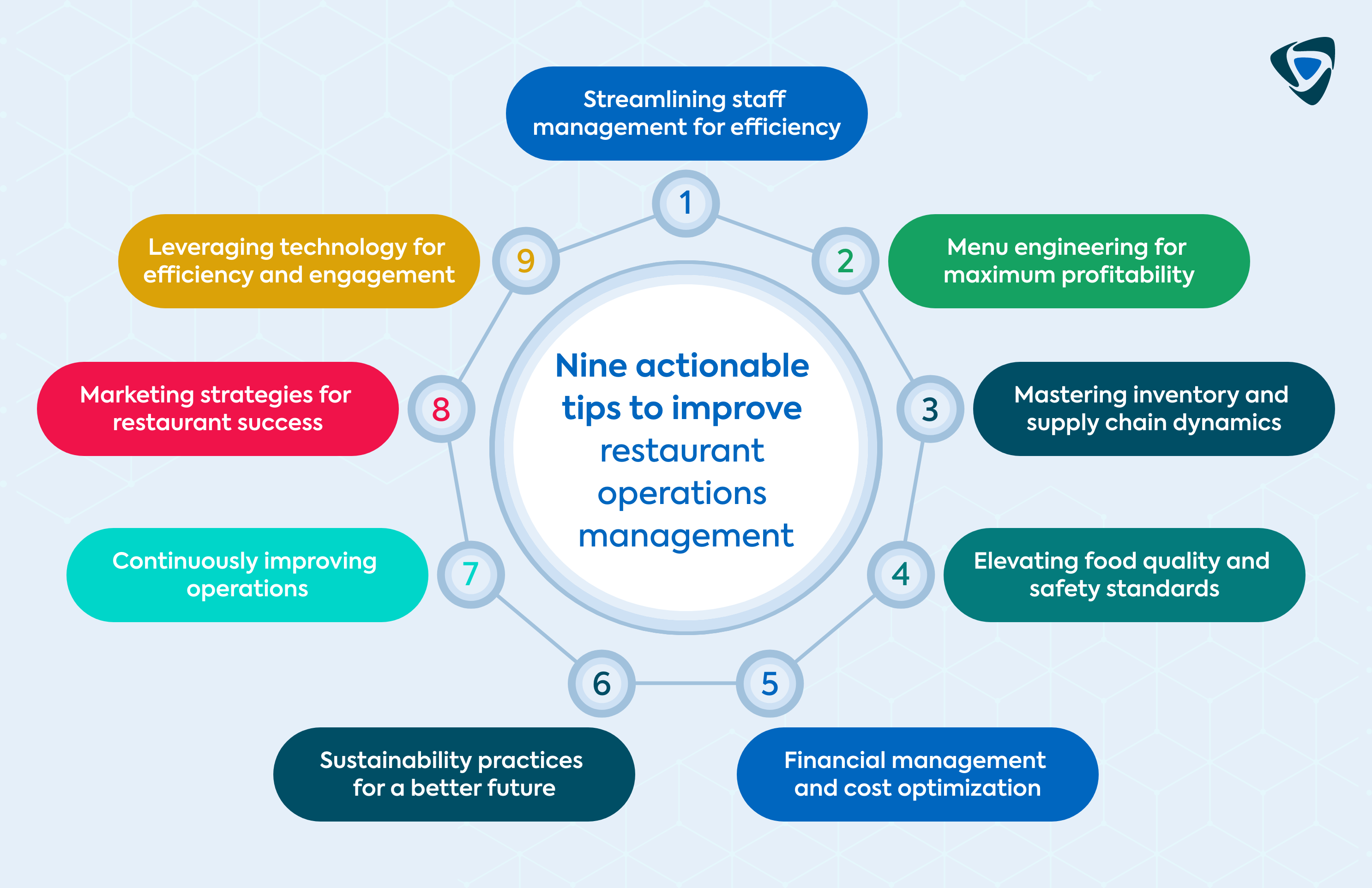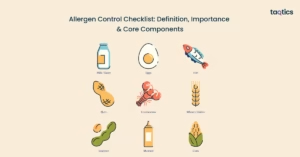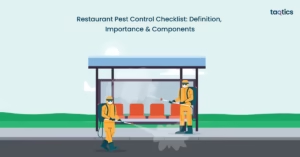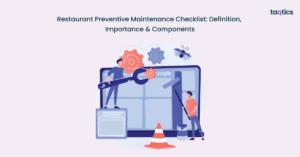How to Improve Restaurant Operations Management?

Working on streamlining restaurant operations is just as important as working on improving the menu, services, and deliveries. It is because everything you deliver depends upon how you manage your kitchen, staff, and atmosphere.
Restaurant operation management is the backbone of your business, and it needs to be robust, dynamic, and ever-ready for every challenge. Are you wondering where to start improving the restaurant operations? This comprehensive guide is your go-to help book, which explores actionable strategies to enhance restaurant operation management, ultimately improving staff and customer experience.
What is restaurant operations management?
Restaurant Management Operations are the basis of the entire restaurant industry. It involves an integrated system to guarantee the smooth operation of all aspects of a business. It requires daily monitoring to ensure optimum performance and alignment of front and back-of-house elements.
In addition, it emphasizes customer satisfaction, employee coordination, overseeing inventory management, effective workflow in the kitchens, and strict food safety policies. The fact that these responsibilities interconnect underlines the importance of a properly implemented operations management strategy.
Well, efficient restaurant operations management does not only entail functionality; it is an essential driver in profitability improvement, cost reduction of overheads and minimizing wastage.
The right operations management could double the profit margins at 15%, as per the National Restaurant Association. It emphasizes the strategic value of an efficient and well-coordinated process, in which pressure for success should not only be directed towards the quality of food but also toward the orchestration of all aspects that contribute to successful dining.
Let’s understand the components of restaurant operation management.
- Inventory Management
- Employee Management
- Restaurant Management Software
- Accounting, CRM, and Marketing
- Menu and POS
- Technical Support and Sales Tracking
- Employee Scheduling Software
- Hardware, Payment Services, and Payroll
- Reporting and Analytics
- Staff Interaction Enhancement
- Customer Loyalty Program Management
- Reservations
- Cloud Reporting
- Customer Feedback and Client Services
- Order Management
- Loyalty Programs and Specials
Nine actionable tips to improve restaurant operations management
Now, you can enhance your restaurant’s efficiency with these nine actionable tips. It will ensure the optimization of operations management for a seamless and successful dining experience.

-
Streamlining staff management for efficiency
Well-trained and enthusiastic staff is the basis for a successful restaurant operation. Employee training is very important. An effective training program ensures that each team member understands their role and what they do daily and makes appropriate choices. It not only improves the quality of service provided but also helps improve the efficiency level of the business.
It is essential to focus on hiring, training and keeping talented people. Success begins with a careful hiring process that emphasizes both skills and cultural affinity. With onboard training, both on-the-job and computer-assisted, employees stay updated with menu items, service procedures and the operation of POS systems.
Retention is equally critical. Having an employee handbook that outlines very specific rules, values and company policies helps create a kind of unity and establishes standards throughout the staff. Customizing training courses and materials for each position recognizes that different positions require distinct expectations and skills, such as servers versus cooks.
Besides, clearly defining job roles and responsibilities guarantees that every staff member knows their place within the operation. This clarity not only improved accountability but also eliminated confusion that would lead to potential conflicts.
Finally, efficient scheduling emerges as the last linchpin in managing staff. Precise scheduling enhances the abilities of staff, defines limits on labour costs and ensures preparedness for unplanned events. No matter if there is a sudden spike in reservations or unexpected no-shows, scheduling always helps to prevent burnout, secure staff’s happiness, and increase productivity, hence resulting in higher-quality hospitality and customer satisfaction.
-
Menu engineering for maximum profitability
Creating a menu that appeals to the target audience is an art form that plays a vital role in proceedings within a successful restaurant. Addressing the variety of culinary offerings usually calls for a good understanding of customers’ preferences, dietary trends, and cultural influences. An intelligently prepared menu attracts not only customers but also a foundation for profitability.
It is essential to spend time studying the profitability and attractiveness of menu items. It includes tracking sales records, identifying the customers’ tastes, and understanding how much each dish contributes towards earning income.
Food costs must always be watched and adjusted regularly without compromising quality to ensure long-run profitability. Metrics such as portion control and inventory management can help cut costs without sacrificing the quality of the dining experience. Using technology to monitor inventories allows for real-time cost tracking and waste management.
Finally, strategically adjusting menu prices is an integral piece of the puzzle. It includes considering the costs of ingredients, market trends and perceived value. Incremental price hikes combined with the articulation of enhancements could improve profitability without alienating customers. In this fragile equilibrium, menu engineering becomes a dynamic utility that maximizes revenue while providing an enjoyable dining experience for patrons.
-
Mastering inventory and supply chain dynamics
Accurate inventory management serves as the key component to operational efficiency in the restaurant business. Besides seamless supply chain management, it also has a significant role to play in eliminating wastage, optimizing costs, and improving overall profitability. Balancing supply with demand would depend on getting the inventory right.
One of the strategic imperatives is building strong supplier relationships. Friendships forged based on mutual trust and transparency not only provide continuous provision of quality ingredients but also pave the way to better bargaining terms. Joint work with suppliers may result in cost-cutting, timely deliveries of goods and procurement of advanced products that positively influence the bottom line.
The best practice for minimizing waste is to implement the “first in, first out” (FIFO) method of inventory. To reduce the risk of perishable items going bad, restaurants should manage to use older inventory before introducing new acquisitions. This approach corresponds with the industry’s sustainability objectives and, at the same time, helps to avoid financial losses caused by spoilage.
Technology is a key contributor to the modernization of inventory tracking and ordering operations. Advanced software solutions make it possible to have stock levels monitored in real-time, reorder triggers triggered automatically and provide the basis for data-driven decision-making. Integration of technology in inventory management allows for not only a higher level of accuracy but increased efficiency and ease of use, allowing restaurants to adapt seamlessly as the culinary world continues to shift and change.
-
Elevating food quality and safety standards
Consistency is the key principle when it comes to providing high-quality food in the restaurant industry. Customers want an enjoyable and predictable dining experience; hence, restaurants need to ensure high-quality standards across all offerings. It should be a signature dish or even a daily special; keeping the taste, presentation and freshness constant is extremely important.
Monitoring and perfecting the processes of food preparation are part of outstanding quality. It involves regular evaluation of cooking methods, ingredient sourcing and portion control to ensure improved culinary results. By using innovative methods and keeping up with industry trends, the menu does not become static; it adapts to changing customer preferences.
In the culinary landscape, it is a non-negotiable aspect to adhere to hygiene and safety regulations. Apart from the requirements created by laws, strict safety measures prevent foodborne illnesses and preserve the name of a given facility. A good food safety strategy starts by ensuring comprehensive safety protocols are followed, equipment is routinely maintained, and health checks happen regularly.
-
Financial management and cost optimization
One of the basic steps to effective financial management in restaurants is creating a comprehensive budget that includes all operational costs. It includes a detailed cost analysis, including costs of ingredients, labor, overheads and other miscellaneous expenditures. A properly defined budget can serve as a guiding framework, help the business allocate its resources strategically and plan for continuous growth.
Cost-control strategies contribute to improving profitability. Operational costs can be optimized by restaurants implementing measures such as inventory management, portion control, and supplier negotiation. Sustainability and energy efficiency practices also lead to long-term cost reduction.
The modern restaurant landscape depends a lot on leveraging technology for financial management. Robust accounting software, point-of-sale systems, and analytics tools offer instantaneous information on financial transactions, thus enabling businesses to keep their work informed. Automation simplifies processes, reduces errors and allows for easy budget management.
In the end, excellent financial management and cost optimization can help restaurants face economic challenges to be profitable and ensure long-term growth. By applying such proactive financial practices and by taking advantage of technological developments, establishments can position themselves to be successful in a dynamic and competitive industry long-term.
-
Leveraging technology for efficiency and engagement
Advanced technology solutions are reshaping the restaurant business by improving its operational efficiency and customer satisfaction. POS systems and reservation platforms have a key role to play in enhancing the efficiency of order processing, table management, and customer bookings. These technologies are integrated seamlessly into the front-of-house operations, thus reducing waiting times and ensuring a smoother dining experience.
Data analytics is a powerful instrument for understanding customers’ choices and conduct. Through POS systems and internet-based establishments, owners can reap all the information they use to plan menus, promotions, and marketing strategies. As a result, this data-intensive process allows for an individualized approach to customer engagement that, in turn, improves their contentment and loyalty.
In the contemporary world, where time is money, online ordering and delivery platforms play a significant role. By adopting these platforms, restaurants can broaden their reach, serve a bigger audience, and adapt to diverse consumer tastes. This convenience model not only marks a cash cow but also meets the growing demand for versatile dining structures.
-
Marketing strategies for restaurant success
The growth and prosperity of a restaurant should be characterized by a constant inflow of customers, which can only be achieved by developing powerful marketing strategies. Channels such as social media, promotions and loyalty programs can be utilized to enhance customer engagement and loyalty. Social media is a strong tool through which the restaurant can show its image, post special offers, and interact with the audience, establishing an atmosphere of community.
Promotions and rewards programs attract new customers but also create incentives for repeat business. Special discounts, deals and loyalty programs build a good rapport with customers, improving brand loyalty and positive word-of-mouth marketing.
Therefore, in the age of digitalization, one needs to have a strong online presence. Good site design, active social media pages and good customer reviews make up a positive public image. Enticing images online can attract new clients and influence their decision-making.
The restaurant has to establish a positive reputation based on favourable customer comments. Happy customers who have posted their stories on the website would make other people visit the restaurant and leave a positive spin on its reputation.
-
Continuously improving operations
In the constantly evolving environment of restaurants, one must continuously evaluate and redefine the operational procedures to maintain success. Highlighting the requirement of ongoing developments helps the restaurant to continue being responsive to changing customer preferences, industry trends, and emerging technologies.
Customer feedback is a good mechanism to identify improvement areas. Actively soliciting and reviewing feedback gives insights into customer satisfaction, enabling the restaurant to identify issues at an early stage and make required changes. Equally significant is the need to keep abreast of industry developments, as it enables an establishment to adopt new practices in line with changing consumer preferences.
Operational improvement is also given a significant boost when an environment of innovation and creativity among employees is developed.
-
Sustainability practices for a better future
In the contemporary restaurant environment, it is more of a necessity to adopt sustainability practices rather than just a trend. Acknowledging the importance of sustainability in operations is another crucial move towards a better future. Restaurants, unlike any other industry, occupy a privileged space to positively contribute through sustainable business practices that tackle environmental issues and appeal to conscious customers.
Waste reduction and energy conservation are vital strategies that promote sustainability in restaurant operations. Establishing effective waste management procedures, recycling schemes and the use of energy-efficient technologies all help to reduce their environmental footprint. By focusing on these practices, restaurants show corporate responsibility and often become profitable in the long term.
One more powerful sustainability strategy includes using local and seasonal products. This approach is beneficial in that it helps local farmers and businesses but also helps to reduce the carbon footprint due to transporting ingredients long distances. Utilizing fresh, local produce upgrades the dishes’ quality as more consumers favour restaurants that practice sustainability and have a connection to communities.
Sustainable practices also encompass benefits beyond environmental concerns. Sustainable restaurants often end up having stronger relationships with their communities, appealing to environmentally savvy consumers, and developing a favourable brand image. By implementing these strategies in everyday activities, restaurants can contribute significantly to the creation of a more sustainable and viable future.
Wrapping up,
Incorporating these proven strategies into your restaurant’s operations management can lead to enhanced customer satisfaction, increased profitability, and a competitive edge in the market. By continuously striving for excellence and implementing innovative approaches, you can ensure the success and growth of your restaurant in today’s dynamic dining landscape.



